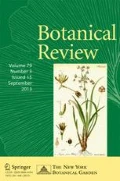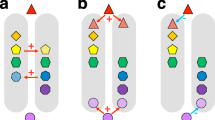Abstract
An important element of the biogeography of species is the geographic aspects of speciation. The geography of species has a role in the processes of speciation which have a reciprocal role in species geography.
The homosporous ferns provide an especially favorable group for biogeographic studies because nearly all species have an equivalent capacity for dispersal and migration. Species ranges are based on the ecology of the environment, rather than on animal vectors of dispersal or pollination. However, with allowance for these differences, the processes of geographic speciation are basically the same in ferns and other vascular plants, although often on a broader geographic scale in the ferns.
Speciation most frequently produces a new species with a small range, which can rapidly expand to occupy the geography of the environment to which the species is adapted. The members of a closely related speciesgroup retain their morphological and geographic relations for a relatively short time. With speciation, changes in distribution, and extinction, the original relations of the species and the biogeographical history of the group will be lost.
High regional species diversity occurs in the wet mountainous regions of the tropics, where there is greatest ecological diversity and maximal opportunities for speciation and persistence.
Resúmen
Los aspectos geogŕaficos de la especiación son elementos importantes en la biogeografía de las especies. La geografía de las especies juega un papel importante en los procesos de especiación, y éstos, a su vez, juegan un papel importante en la geografia de las especies.
Los helechos homósporos constituyen un grupo especialmente favorable para estudios biogeográficos ya que casi todas las especies tienen una capacidad de dispersíon y migración similar. Las distribuciones de las especies están más bien basadas en la ecologia del medio ambiente que en vectores animales para las dispersión o polinización. Sin embargo con la excepción de estas diferencias, los procesos de especiación geográfica en helechos y otras plantas vasculares son básicamente iguales, aunque algunas veces en los helechos ocurren sobre una escala geográfica más amplia.
Con mucha frecuencia el proceso de especiación produce un especie nueva con un área de distribución pequena, que rapidamente se expande para ocupar la geografia del medio ambiente a la cual la especie está adaptada. Los miembros de un complejo de especies relacionadas retienen sus relaciones morfológicas y geográficas por un tiempo relativimente corto. Con el proceso de especiación, los cambios en la distribución, y extinción, las relaciones originales de las especies y la historia biogeográfica del grupo se perderán.
Existe una alta diversidad de especies en los áreas tropicales más humedas y montañosas, donde la diversidad ecológica es más alta y los oportunidades para la especiación y persistencia son máximas.
Similar content being viewed by others
Literature Cited
Alt, K. S. &V. Grant. 1960. Cytotaxonomic observations on the goldback fern. Brittonia12: 153–170.
Brownlie, G. 1962. Geographical relationships of New Zealand fern flora. Pacific Sci.16: 363–365.
Carson, H. L. &A. R. Templeton. 1984. Genetic revolutions in relation to speciation phenomena: The founding of new populations. Annual Rev. Ecol. Syst.15: 97–131.
Conant, D. S. 1976. Ecogeographic and systematic studies in American Cyatheaceae. Ph.D. Thesis. Harvard University.
—. 1978. A radioisotope technique to measure spore dispersal of the tree fernCyathea arborea Sm. Pollen et Spores20: 583–593.
—. 1983. A revision of the genusAlsophila (Cyatheaceae) in the Americas. J. Arnold Arbor.64: 333–382.
— &G. Cooper-Driver. 1980. Autogamous allohomoploidy inAlsophila andNephelea (Cyatheaceae): A new hypothesis for speciation in homoploid homosporous ferns. Amer. J. Bot.67: 1269–1288.
Gibby, M. 1979. Paleoendemism and evolution in MacaronesianDryopteris. Pages 347–358in D. Bramwell (ed.), Plants and islands. Academic Press, London.
Groves, E. W. 1981. Vascular plant collections from the Tristan da Cunha group of islands. Bull. Brit. Mus. (Nat. Hist.), Bot.8: 333–420.
Hennipman, E. 1977. A monograph of the fern genusBolbitis (Lomariopsidaceae). Leiden Bot. Series2: 1–331.
Holttum, R. E. 1964. The tree ferns of the genusCyathea in Australasia and the Pacific. Blumea12: 241–274.
Jalas, J. &J. Suominen. 1972. Atlas florae Europeae. 1. Pteridophyta. The Committee for Mapping the Flora of Europe. Academic Bookstore, Helsinki.
Kepler, A. K. 1975. Common ferns of Luquillo Forest, Puerto Rico. Inter American University Press, San Juan.
Kramer, K. U. 1970. The lindsaeoid ferns of the Old World V. The smaller Pacific islands. Blumea18: 157–194.
—. 1978. The pteridophytes of Suriname. Natuurwetschap. Stud. Suriname Nederl. Antillen93: 1–198.
Lang, F. A. 1969. A new name for a species ofPolypodium from northwestern North America. Madroño20: 53–60.
Lellinger, D. B. 1984. Hymenophyllopsidaceae (Filicales). Mem. New York Bot. Gard.38: 1–9.
Lloyd, R. M. &E. J. Klekowski. 1970. Spore germination and viability in Pteridophyta: Evolutionary significance of chlorophyllous spores. Biotropica2: 129–137.
Maxon, W. R. 1926. Pteridophyta. Sci. Survey Porto Rico Virgin Islands6: 373–521. New York Academy of Sciences.
Mitchell, R. S. 1984. Atlas of New York State ferns. New York State Mus. Bull.456: 1–28.
Oinonen, E. 1967. The correlation between the size of Finnish bracken (Pteridium aquilinum (L.) Kuhn) clones and certain periods of its site history. Acta Forest. Fenn.83(2): 1–51.
Page, C. N. 1982. The ferns of Britain and Ireland. Cambridge University Press, Cambridge.
Perez-Garcia, B. &R. Riba. 1982. Germination de esporas de Cyatheaceae bajo diversas temperatures. Biotropica14: 281–287.
Proctor, G. R. 1977. Pteridophyta. Vol. 2in R. A. Howard (ed.), Flora of the Lesser Antilles. Arnold Arboretum, Jamaica Plain, Massachusetts.
—. 1985. Ferns of Jamaica. British Museum (Natural History), London.
Raynor, G. S., E. C. Ogden &J. V. Hayes. 1976. Dispersion of fern spores into and within a forest. Rhodora78: 473–487.
Reichstein, T. 1981. Hybrids in European Aspleniaceae (Pteridophyta). Bot. Helvetica91: 89–139.
Schneller, J. J. 1979. Biosystematic investigations on the lady fern (Athyriumfilix-femina). Plant Syst. Evol.132: 255–277.
— &B. W. Schmid. 1982. Investigations on the intraspecific variability inAthyrium filix-femina (L.) Roth. Adansonia 3–4: 215–228.
Smith, A. R. 1981. Pteridophytes. Part 2in D. E. Breedlove (ed.), Flora of Chiapas. California Academy of Science, San Francisco.
Sota, E. R. de la. 1966. Revision de las especies Americanas del groupoPolypodium squamatum L. Revista Mus. La Plata, Secc. Bot.10: 69–186.
Stolze, R. G. 1974. A taxonomic revision of the genusCnemidaria (Cyathecaeae). Fieldiana, Bot.37: 1–98.
Stone, B. C. 1959. The flora of Namonuito and the Hall Islands. Pacific Sci.13: 88–104.
Tardieu-Blot, M. L. 1951–1960. 1–9 Famillein H. Humbert (ed.), Flore de Madagascar et des Comores. Paris.
Tryon, A. F. 1957. A revision of the genusPellaea sectionPellaea. Ann. Missouri Bot. Gard.44: 125–193.
—. 1962. A monograph of the fern genusJamesonia. Contr. Gray Herb.191: 109–197.
—. 1966. Origin of the fern flora of Tristan de Cunha. Brit. Fern Gaz.9: 269–276.
—. 1968. Comparisons of sexual and apogamous races in the fern genusPellaea. Rhodora70: 1–24.
—. 1970. A monograph of the fern genusEriosorus. Contr. Gray Herb.200: 54–174.
Tryon, R. 1942. A revision of the genusDoryopteris. Contr. Gray Herb.143: 1–80.
—. 1956. A revision of the American species ofNotholaena. Contr. Gray Herb.179: 1–106.
—. 1970. Development and evolution of fern floras of oceanic islands. Biotropica2: 76–84
—. 1971a. The American tree ferns allied toSphaeropteris horrida. Rhodora73: 1–19.
—. 1971b. The process of evolutionary migration in species ofSelaginella. Brittonia23: 89–100.
—. 1972. Endemic areas and geographic speciation in tropical American ferns. Biotropica4: 121–131.
—. 1976. A revision of the genusCyathea. Contr. Gray Herb.206: 19–98.
—. 1979. Biogeography of the Antillean fern flora. Pages 55–68in D. Bramwell (ed.), Plants and islands. Academic Press, London.
—. 1985. Fern speciation and biogeography. Proc. Roy. Soc. Edinburgh86, sect. B: 353–360.
— &D. S. Conant. 1975. The ferns of Brazilian Amazonia. Acta Amazonica5: 23–34.
— &A. F. Tryon. 1982. Ferns and allied plants with special reference to tropical America. Springer-Verlag, New York.
Wace, N. M. &J. H. Dickson. 1965. The terrestrial botany of the Tristan da Cunha islands. Philos. Trans. Roy. Soc. London, Ser.B. 249: 273–360.
Walker, T. G. 1958. Hybridization in some species ofPteris. Evolution12: 82–92.
Warne, T. R. &R. M. Lloyd. 1980. The role of spore germination and gametophyte development in habitat selection: Temperature responses in certain temperate and tropical ferns. Bull. Torrey Bot. Club107: 57–64.
Werff, H. van der &A. R. Smith. 1980. Pteridophytes of the State of Falcón, Venezuela. Opera Bot.56: 1–34.
Werth, C. R., S. I. Guttman &W. H. Esbaugh. 1985. Recurring origins of alloploid species inAsplenium. Science228: 731–733.
Widén, C-J. &D. M. Britton. 1985. Phloroglucinol derivatives ofDryopteris tokyoensis and the missing genome inD. cristata andD. Carthusiana. Ann. Bot. Fenn.22: 213–218.
Windham, M. D. &C. H. Haufler. 1985. Autoploid evolution among homosporous ferns. Amer. J. Bot.72: 919. Abst. 344.
Windisch, P. G. 1978.Sphaeropteris (Cyatheaceae). The systematics of the group ofSphaeropteris hirsuta. Mem. New York Bot. Gard.29: 2–22.
Author information
Authors and Affiliations
Rights and permissions
About this article
Cite this article
Tryon, R. The biogeography of species, with special reference to ferns. Bot. Rev 52, 117–156 (1986). https://doi.org/10.1007/BF02860999
Issue Date:
DOI: https://doi.org/10.1007/BF02860999




